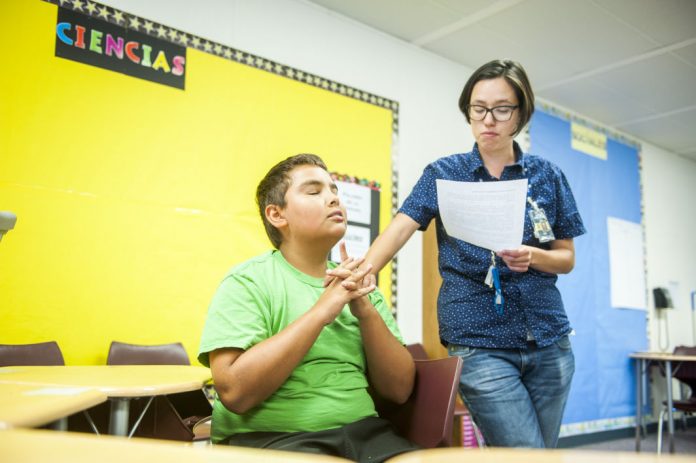
The student closed his eyes and thought carefully how to spell the word for government in Spanish: “g-o-b-i-e-r-n-o,” he said.
Meanwhile, Tánit Arzate, a visiting teacher from Mexico City, watched.
The student—and his 12 classmates—spend half their day speaking Spanish and the other half communicating in English at the Hollister Dual Language Academy. The academy is run mostly from portable classrooms at a campus shared with Gabilan Hills School off Santa Ana Road.
Demand for the academy increased dramatically in recent years, so much so that in January, Hollister School District trustees approved making the campus a K-8 site. The formerly K-6 school doubled its number of kindergarten students last year and added seventh graders to the campus this year. In 2016-17, those seventh graders—like the one spelling in Spanish in Arzate’s classroom—will become the school’s first on-site eighth graders.
When HDLA Principal Monique Ruiz first took control of the site three school years ago, the waiting list was about 90 students long, she said. There were typically only 20 to 30 open spots after siblings of existing students were accepted into the program, since they get preferential enrollment, the principal said.
“It was hard to get in,” she said.
The movement to expand the school by two grades came partly due to a statewide call for smaller classrooms sizes. The state’s new Local Control Funding Formula class size incentive requires all schools in the district to make progress toward smaller classes each year until 2021.
Since students can’t easily join the program after first grade unless they are from a Spanish-speaking country or have been in another dual-language program, the academy mostly takes new students in kindergarten and first grade and doesn’t replace them in the upper grades, if they leave.
“We were in danger of losing the program down the line,” Ruiz said.
If students left, two classes of 24 students might become just a class and a half by fourth grade, which would mean the academy would have to run multi-grade classes to keep the program going, Ruiz explained.
So trustees visited the site and decided it was time to expand.
“They went out on a limb and they said, ‘Yes, we’re going to let you guys grow,’” the principal said from her office, where colorful masks lined the window.
The waiting list was about two to three students last year—following the doubling of the school’s kindergarten classes—and was none this year, she said.
Back in Arzate’s classroom, the students played a game where children spelling the words correctly in Spanish with their eyes closed had the chance to see if a paragraph from an essay was beneath their seat. If they found a piece of paper with a paragraph, they had a chance to place it on the board under the appropriate essay category: title, introduction, argument, conclusion and reference.
“You could see the kids were super engaged,” Ruiz said. “And they were practicing essay parts, but they were also talking about global warming.”
And they were speaking Spanish, the principal added.
Just outside the school gates, parents of the school’s newest students waited to pick up their kindergarteners.
“I signed him up because I heard so many good things about it,” said Claudia Nuñez, 26.
Her son, Oscar Rodriguez, 5, didn’t speak Spanish but understood it because that was the language of both sets of grandparents, Nuñez said. The boy had started at Sunnyslope School but his attitude toward class changed when he came to this campus, she said.
“He looks forward to coming to school every day and that’s new for us,” she said.









